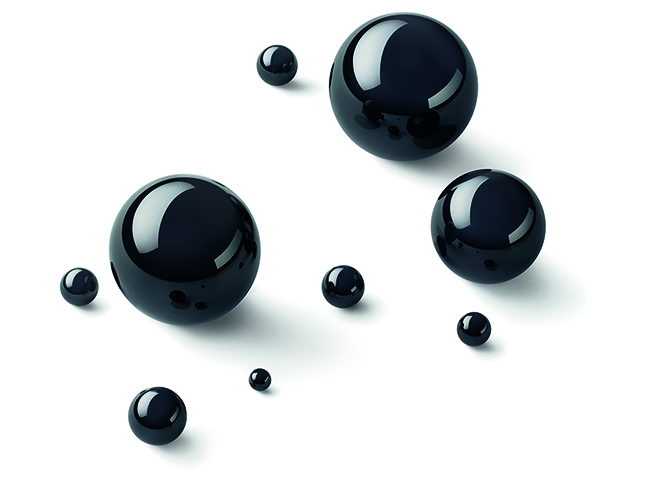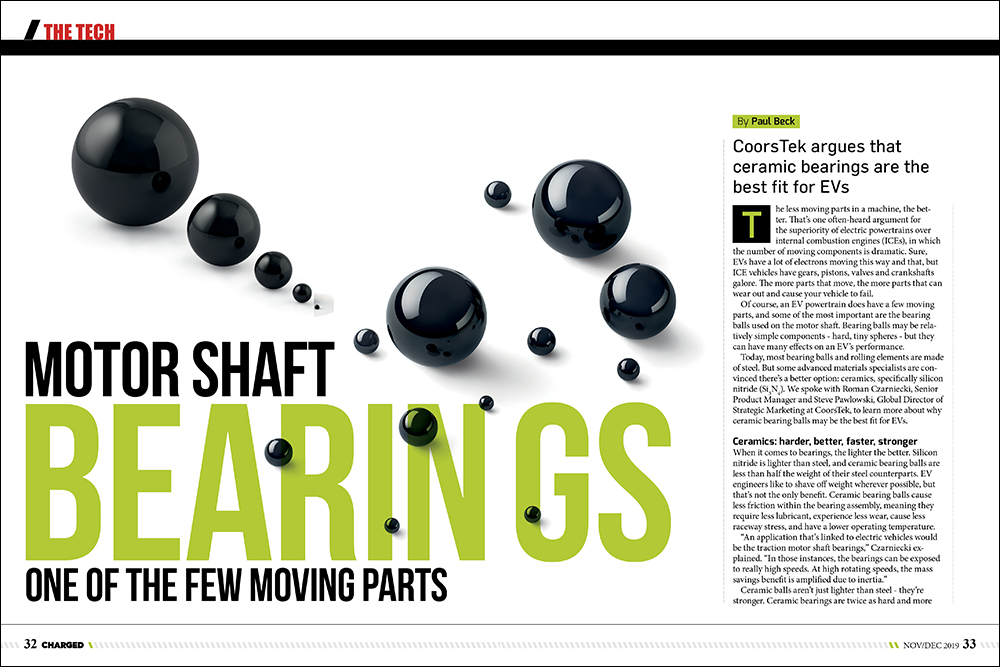CoorsTek argues that ceramic bearings are the best fit for EVs
The less moving parts in a machine, the better. That’s one often-heard argument for the superiority of electric powertrains over internal combustion engines (ICEs), in which the number of moving components is dramatic. Sure, EVs have a lot of electrons moving this way and that, but ICE vehicles have gears, pistons, valves and crankshafts galore. The more parts that move, the more parts that can wear out and cause your vehicle to fail.
Of course, an EV powertrain does have a few moving parts, and some of the most important are the bearing balls used on the motor shaft. Bearing balls may be relatively simple components – hard, tiny spheres – but they can have many effects on an EV’s performance.
Today, most bearing balls and rolling elements are made of steel. But some advanced materials specialists are convinced there’s a better option: ceramics, specifically silicon nitride (Si3N4). We spoke with Roman Czarniecki, Senior Product Manager and Steve Pawlowski, Global Director of Strategic Marketing at CoorsTek, to learn more about why ceramic bearing balls may be the best fit for EVs.
Ceramics: harder, better, faster, stronger
When it comes to bearings, the lighter the better. Silicon nitride is lighter than steel, and ceramic bearing balls are less than half the weight of their steel counterparts. EV engineers like to shave off weight wherever possible, but that’s not the only benefit. Ceramic bearing balls cause less friction within the bearing assembly, meaning they require less lubricant, experience less wear, cause less raceway stress, and have a lower operating temperature.
“An application that’s linked to electric vehicles would be the traction motor shaft bearings,” Czarniecki explained. “In those instances, the bearings can be exposed to really high speeds. At high rotating speeds, the mass savings benefit is amplified due to inertia.”
Ceramic balls aren’t just lighter than steel – they’re stronger. Ceramic bearings are twice as hard and more than 60 percent stiffer than steel, which makes them less prone to deformation. “[Ceramics] are very, very hard,” Czarniecki said. “This plays in extremely well when you think about bearing life and bearing efficiency.”
Ceramic balls can actually “heal” metal races. Metal races have inherent surface imperfections due to their manufacturing process. These imperfections are removed over time thanks to the very hard, very smooth surface of the balls.
Another advantageous property of ceramics is their ability to withstand high temperatures. Ceramic bearing balls can operate at temperatures up to 1,000° C, far exceeding typical automotive operating requirements. “Because we can handle much higher temperatures before we have mechanical property breakdown, we can survive oil drought far better than steel,” Czarniecki explained. Oil drought refers to a lack of sufficient lubrication in the bearings, which can occur in cold start and other situations. Improperly oiled bearings mean more friction and more localized heat, which can cause the bearings to break down faster. Ceramics also prevent “cold welding” between the rolling element and the races due to lack of lubrication. The dissimilar materials do not attach to each other as metal on metal might do.

Resistance and longevity
For EVs, one of the biggest benefits of ceramic bearing balls is that they’re electrically resistant. You don’t want current running through your bearings. For one thing, it’s an unintentional short circuit, and for another, it hastens the breakdown of the bearings.
“Silicon nitride is electrically resistant, which is generally a benefit in almost all bearing applications,” said Czarniecki. “This one really hits home with electric drivetrain applications. When you think of high-voltage traction motors in a car, there is high propensity for electrical pitting to occur inside the bearings due to current leakage that can ultimately lead to early failures.”
If you’re set on steel bearings but you still require electrical resistance, the only option is to coat the steel in an insulative material. However, this adds complexity to the manufacturing process and presents the opportunity for quality contamination. “Generally, simpler manufacturing processes for automotive quality and volumes are preferred, and silicon nitride has the property built into the material,” Czarniecki said.
Finally, ceramic bearings last longer than steel. Bearings can be replaced when they wear out, but who needs the hassle? For Pawlowski, the added longevity of ceramic bearings is an important consideration for the business models springing up alongside EVs.
“What it means is you eliminate a maintenance schedule, especially for things like robo-taxis or ride sharing applications, where vehicles might be trying to get hundreds of thousands of miles out of them,” Pawlowski explained. “Maybe they have a 100-thousand-mile bearing change-out if they go with steel…but perhaps you can keep your single set of hybrid ceramics for the life of the vehicle and get half a million miles.”

The cost of ceramics
Ceramic bearing balls aren’t exactly a new idea. In 2001, NASA used silicon nitride balls on the Space Shuttle’s redesigned hydrogen turbopump. The performance advantages of ceramics have been known even longer, since the early 1970s. Yet steel bearings remain commonplace for a simple reason: cost. Ceramic bearings are more expensive than steel, though the price is on a consistent downward trajectory.
The situation reminds Pawlowski of battery cells, which have been consistently falling in price, and thus spurring the EV industry’s explosive growth. “This is not battery cells,” Pawlowski was careful to clarify. “But, like other technologies that aren’t mainstream in vehicles today, there’s a scale tipping point that really makes things economically feasible.”
In Pawlowski’s view, that point is approaching for ceramic bearings.
“I have yet to meet with a customer or prospective customer that would say, ‘No, we think steel serves the purpose, performs better from a technical standpoint.’ I think that historically, the barrier has been cost, but with the EV market growing we’re seeing that barrier begin to decrease,” he said.
CoorsTek Cerbec
CoorsTek, which considers itself a pioneer of ceramic bearing technology, offers a premium ceramic product line called Cerbec. The most popular Cerbec bearing element type is a ball, though the company produces many shapes. Cerbec balls range from 0.5 mm to 50 mm in diameter, and are used in a variety of applications, including aerospace, medicine, energy, and of course, automotive.
In practice, most ceramic bearings can be considered hybrid bearings in the sense that they combine ceramic balls with steel raceways. A purely ceramic bearing is possible, but because ceramic is so smooth, there wouldn’t be enough friction in the system. “You don’t roll, you slide,” Pawlowski illustrated.
Even in hybrid bearings, the smoothness of ceramic can prove problematic if not controlled. If the bearing balls are too smooth, they become resistant to lubrication.
“We actually have to control and make sure we don’t get smoother than we want,” explained Pawlowski. “It’s undetectable with a human eye, but on a molecular level, we can get so smooth that there’s no room for oil film.”
To manufacture ceramic balls, CoorsTek formulates raw silicon nitride powder, carefully controlling for properties including particle size, density, symmetry, and moisture content. After some chemical binders are added, the powder is formed in a blank before moving on to grinding, tumbling, and polishing. CoorsTek also puts the balls through a process called hot isostatic pressing for proper microstructural development, which results in greater hardness and toughness, and less rolling contact fatigue.
“That, in addition to our control during the finish process, are probably the reasons why Cerbec has become the gold standard in the industry,” Pawlowski said.
Balls, cylinders, and more
Though balls are the most common shape of CoorsTek’s ceramic bearing elements, the company also produces shapes such as cylinders and tapered rollers (which look like a cone with the tip sliced off). The shape depends on the specific application, but no matter the shape, the benefits of ceramics apply.
“With all of the major Tier 1 driveline motor manufactures and vehicle OEMs we’ve chatted with, most of the time we’re talking about bearing balls,” Pawlowski said. “But we also do other rolling elements. The processing is a little bit different, the way that we form the shape is different, but beyond that, everything we talked about before applies.”
Other things being equal, ball bearings generally can’t support as high a load as cylindrical bearings can, because the contact between raceway and rolling elements is smaller (a point instead of a line). However, this also means that less friction is created, so ball bearings are typically better at sustaining higher speeds than cylindrical bearings. In certain applications, tapered rollers and other rolling elements provide better performance than either balls or cylinders.
The EV industry is still nascent, and it will undoubtedly find ways to innovate and improve on its key technologies: batteries, chargers, and electric motors. But as we’ve seen, even the oldest and seemingly simplest of technologies – hard, tiny spheres – can be a part of the EV revolution. And for that revolution to revolve best, ceramic ball bearings could be critical.
This article appeared in Charged Issue 46 – November/December 2019 – Subscribe now.




















































































